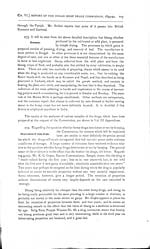Medicine - Drugs > Report of the Indian Hemp Drugs Commission, 1894-1895 > Volume I
(132) Page 104
Download files
Individual page:
Thumbnail gallery: Grid view | List view

104 REPORT OF THE INDIAN HEMP DRUGS COMMISSION, 1893-94. [CH. VI.
Regarding the keeping
properties of charas, the information must necessa-
rily be inexact, as it is an imported article, and it is
practically impossible for the
real age of any particular sample to be known. From its physical
properties
charas admits of being readily adulterated, and the strikingly
marked differences
in the physiological value of charas resin as determined by Dr.
Evans would also
appear to support this view. From the various modes which appear to
be adopt-
ed for the preparation of commercial charas, it must always be a
drug of more
or less uncertain composition, and not undeserving of the
appellation—" A foul
and crude drug, the use of which is properly excluded from
civilized medicine,"
which was applied to it by the famous pharmacologists Flückiger and
Hanbury.
Some witnesses appear to consider that charas is perhaps more
stable than ganja.
Gujar Mal, Punjab Witness No. 93, a drug vendor for twenty years,
states that
charas is very strong during the first year; after that it
gradually loses its strength
until the fourth year, when it becomes quite useless. Some
witnesses refer to
the deterioration being more rapid in the plains than at hill
stations. A witness
refers to charas produced in Bokhara which can be kept for six
years in India
without going bad.
Causes of deterioration.
275. The causes of the deterioration of
ganja and bhang are usually ascribed
to (a) damp
and natural decay; (b) ravages of insects,
and also popularly
(c) to volatilization of the
narcotic principle.
Regarding the two first causes of deterioration, they are
common to all vegetable substances; but the third cause is not
tenable because
hemp resin on which the narcotic property of the drug depends is
non-volatile.
There is no doubt, however, that by prolonged exposure to air the
aroma of the
drug is dissipated to a considerable extent, the aroma being due to
the presence
of a volatile oil. The popular view of the value of ganja is based
on its physical
appearance, and very largely also on its aroma; but it does not
necessarily follow
that because the aroma has been lost, the drug is therefore weaker
in narcotic
property; but it may be less pleasant to smoke than ganja which has
retained
its bouquet. The mere effluxion of time without other disturbing
factor, such as
damp, as a cause of the impairment in the narcotic value of the
drug is a point of
some interest. In medical circles there is a fairly general idea
that the extract
of Cannabis indica is an uncertain drug, and this is
believed to be due to varia-
tions in age of the preparations which have been prescribed. This
assumption
may or may not be correct. Dr. Evans' experiments indicate that the
physiological
values of similar doses of all alcoholic resinous extracts from
various ganjas are
not the same, and, moreover, individual idiosyncrasy on the part of
the patients
as influencing the action of the drug has perhaps not been always
recollected. The
alleged diminution in power of the drug by ellluxion of time might
be ascribed as
being really clue to a slow oxidation process, and that this might
readily occur
in ganja is explicable. But as regards the extract of Cannabis
indica, direct oxida-
tion would only occur superficially in the stratum exposed to air.
But there
is no evidence of any value to prove that ganja, which has been
carefully protect-
ed from damp, and say five years old, is not as active
physiologically as the
fresh drug. The value of ganja for use has always hitherto been
determined
solely by its physical appearances. With evidence of mould and the
effects of
continued damp, the physical appearances are sufficient for an
opinion to be
arrived at; but when those signs of deterioration are absent, mere
loss of aroma,
Set display mode to: Large image | Zoom image | Transcription
Images and transcriptions on this page, including medium image downloads, may be used under the Creative Commons Attribution 4.0 International Licence unless otherwise stated. ![]()
| India Papers > Medicine - Drugs > Report of the Indian Hemp Drugs Commission, 1894-1895 > Volume I > (132) Page 104 |
|---|
| Permanent URL | https://digital.nls.uk/74574332 |
|---|---|
| Description | [Volume 1]: Report. |
|---|---|
| Attribution and copyright: |
|




